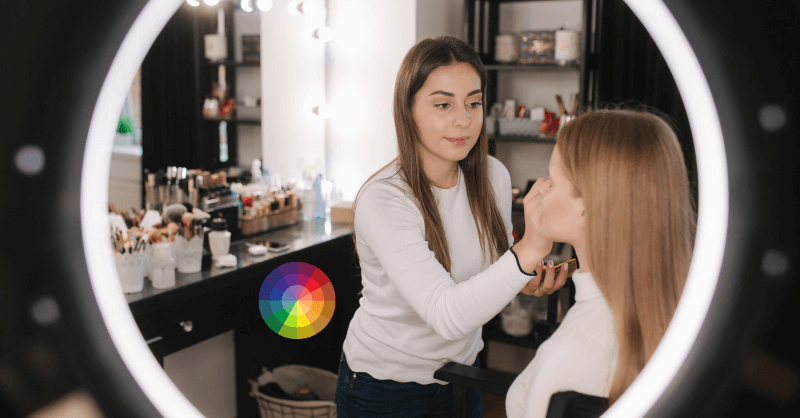
Have you ever raided your makeup collection, feeling paralyzed by the endless sea of eyeshadow palettes, lipsticks, and foundations?
You’re not alone! Staring down a rainbow of colors can be daunting, especially when you’re unsure which shades will make your eyes sparkle or your skin look radiant.
The secret weapon you need? Color theory. It might sound intimidating, but fear not! This blog is your crash course into the fascinating world of color theory for makeup application. Here, you’ll learn how colors interact and influence each other, empowering you to create truly captivating looks.
Forget memorizing a bunch of scientific jargon. This is about unleashing your inner makeup artist and taking control! Imagine confidently choosing foundations that flawlessly match your skin tone, eyeshadow palettes that bring out the vibrancy of your eyes, and lipsticks that enhance your natural beauty.
With color theory as your guide, you’ll transform from a makeup novice to a makeup magician, creating personalized looks that have everyone asking, “What makeup are you wearing?” Ditch the guesswork and embrace the science of stunning makeup!
From Makeup User to Makeup Magician
Imagine this: you effortlessly pick a foundation that blends seamlessly with your skin tone. You discover eyeshadow palettes that make your eyes sparkle like never before. And you find lipsticks that enhance your natural beauty, leaving you feeling confident and radiant.
Demystifying the Color Wheel: Your Guide to Color Harmony
Let’s begin by unpacking the magic tool that unlocks color theory’s secrets: the color wheel. It’s a circular chart that visually organizes colors based on their relationships to each other. Think of it as a map for navigating the world of makeup colors!
The color wheel features two main categories: primary colors (red, yellow, and blue) and secondary colors (orange, green, and purple), which are created by mixing primary colors. There are also tertiary colors formed by mixing secondary colors.
But what makes the color wheel truly powerful is how it highlights color relationships:
Complementary Colors: These are colors directly opposite each other on the wheel (think red and green, blue and orange). When placed next to each other, they create a high-contrast, eye-catching effect. Think a bold red lip with a touch of green eyeshadow to make it pop!
Analogous Colors: These are colors that sit next to each other on the wheel (think blue, blue-green, and green). They create a harmonious and cohesive look because they share similar undertones. Analogous color palettes are perfect for creating a natural, everyday look.
Triadic Colors: These are three colors evenly spaced around the wheel (think red, yellow, and blue). Triadic palettes can be quite striking, but they require a more skilled hand to blend seamlessly.
Understanding Warmth & Coolness: The Key to Flattering Your Skin Tone
Complementary Colors: These are colors directly opposite each other on the wheel (think red and green, blue and orange). When placed next to each other, they create a high-contrast, eye-catching effect. Think a bold red lip with a touch of green eyeshadow to make it pop!
Analogous Colors: These are colors that sit next to each other on the wheel (think blue, blue-green, and green). They create a harmonious and cohesive look because they share similar undertones. Analogous color palettes are perfect for creating a natural, everyday look.
Triadic Colors: These are three colors evenly spaced around the wheel (think red, yellow, and blue). Triadic palettes can be quite striking, but they require a more skilled hand to blend seamlessly.
Now that you’ve grasped the basics of the color wheel, let’s delve deeper into a crucial aspect – warmth and coolness. Every color has an undertone, which can be either warm (yellow, orange, peach) or cool (blue, pink, red). Identifying your skin’s undertone is vital for choosing makeup that complements your natural beauty.
Here’s a simple trick to identify your undertone:
- Wash your face and remove any makeup.
- Stand in natural daylight (avoid harsh artificial lights).
- Look at your veins on your inner wrist. If they appear greenish, you likely have a warm undertone. If they appear bluish or purple, you have a cool undertone.
Warm Skin Tones: These skin tones have a golden or yellow cast and tend to tan easily. Look for foundations with yellow or peach undertones, blushes with warm hues like coral or peach, and eyeshadow palettes with gold, bronze, or warm brown shades.
Cool Skin Tones: These skin tones have pink or rosy undertones and may burn more easily in the sun. Opt for foundations with pink or neutral undertones, blushes in cool pinks or mauves, and eyeshadow palettes with cooler shades like silver, blue, or taupe.
Neutral Skin Tones: Lucky you! If your veins appear equally green and blue, you have a neutral undertone. You can rock a wider range of colors and experiment with both warm and cool palettes to find what flatters you most.
Mastering Color Schemes: From Everyday Glam to Bold Statements
Now that you understand the color wheel and your skin’s undertone, let’s explore how to create captivating makeup looks using color theory! Here are some popular color schemes to get you started:
Monochromatic Magic:
For a sophisticated and effortless look, try a monochromatic look. This involves using variations of a single color across your face – from foundation and blush to eyeshadow and lipstick. It’s a great option for beginners and creates a streamlined, polished appearance.
Analogous Allure:
Embrace harmony with an analogous color scheme. Choose three colors that sit next to each other on the wheel for
Unleash Your Inner Makeup Magician: Dive Deeper with Color Theory!
That feeling when you create a makeup look that makes you feel like a million bucks? Priceless, right? Color theory can be your secret weapon to achieve that feeling consistently. But this blog post is just the first brushstroke on your artistic canvas!
Imagine having a personalized makeup guide in your pocket, whispering color combinations and techniques that flatter your unique features. That’s the power of mastering color theory for makeup application.
Here are some ways to take your newfound knowledge to the next level:
- Play with Palettes: Now that you understand the color wheel, head to your local makeup store (or raid your existing stash!) and experiment with different palettes. See how the colors interact on your skin. Don’t be afraid to break the “rules” – sometimes, the most stunning looks come from unexpected pairings!
- Practice Makes Perfect: As with any skill, practice is key. Set aside some time to create looks inspired by the color schemes you learned about. Don’t worry about achieving perfection – the goal is to get comfortable working with color. Take selfies to document your progress and track your improvement!
- Embrace Online Inspiration: The internet is a treasure trove of makeup tutorials and looks created with color theory in mind. Follow makeup artists you admire on social media, watch YouTube tutorials, and experiment with recreating looks that resonate with you.
- Join the Community: Feeling overwhelmed? Don’t be afraid to connect with other makeup enthusiasts! Online forums and communities are excellent places to ask questions, share your creations, and get feedback from like-minded individuals.
Remember, the journey of mastering color theory is as unique as you are. There’s no one-size-fits-all approach! Embrace the learning process, have fun experimenting, and most importantly, don’t be afraid to express yourself through the power of color.
Ready to unlock the full potential of color theory in your makeup routine? Here are some resources to keep you on your creative journey:
Download a Color Wheel App: Having a color wheel app on your phone is a handy way to reference color relationships on the go. This can be particularly helpful when shopping for new makeup or choosing colors for a specific look.
Invest in a Quality Makeup Brush Set: Good quality brushes make all the difference in blending and applying makeup flawlessly. This allows you to create seamless transitions between colors and achieve a professional finish.
Explore Online Makeup Courses: There are a plethora of online makeup courses available for all skill levels. Consider taking a course specifically focused on color theory to deepen your understanding and learn advanced techniques.
Remember, you are a work of art in the making!
With color theory as your guide, you can create captivating makeup looks that celebrate your individuality and make you feel confident and radiant. So, grab your makeup brushes, embrace the power of color, and get ready to paint your own masterpiece!
Frequently Asked Questions (FAQ)
Absolutely not! This blog post is designed to be a beginner-friendly introduction to color theory. We break down the concepts into easy-to-understand sections and provide practical tips for using them in your makeup routine.
The blog post includes a simple trick to identify your skin’s undertone (warm, cool, or neutral) by looking at the veins on your wrist. This will help you choose makeup colors that complement your natural beauty.
A! Not necessarily. While cool undertones generally pair well with cool-toned makeup, you can still experiment with warm colors strategically. For example, a pop of warm eyeshadow in the crease can add depth, while a cool-toned lipstick can balance the look.
By understanding color theory, you can make smarter choices when purchasing makeup. You’ll know which colors will flatter you most, preventing impulse purchases that don’t suit your needs. This can help you create a more streamlined and versatile makeup collection.


